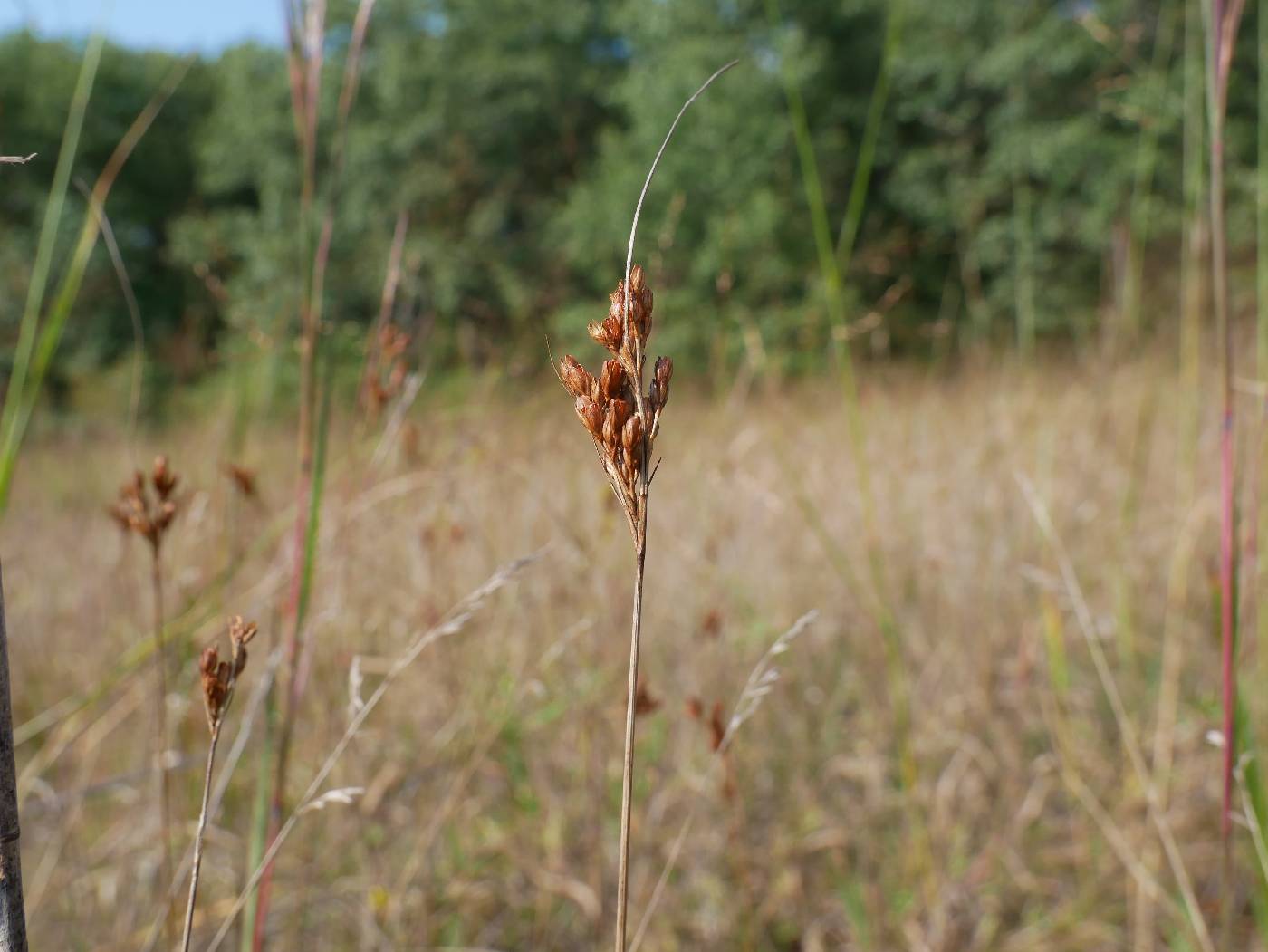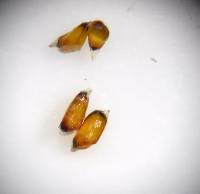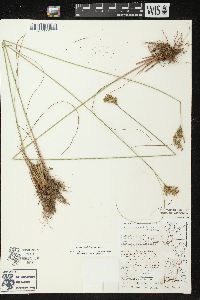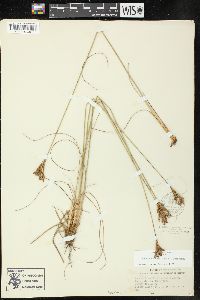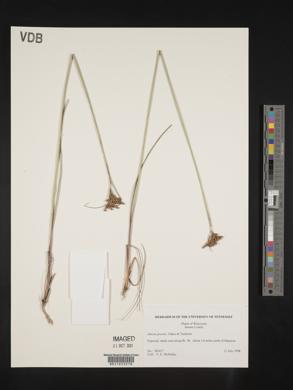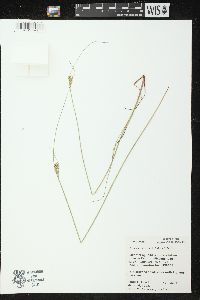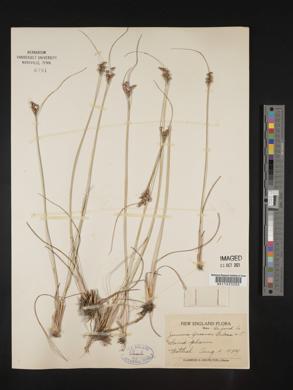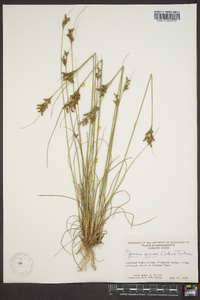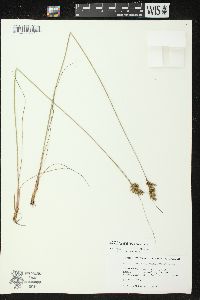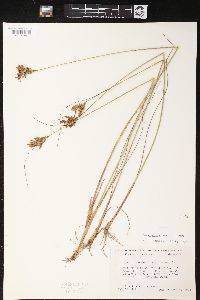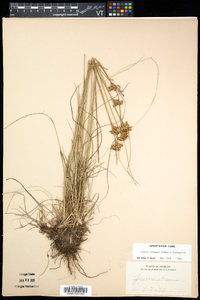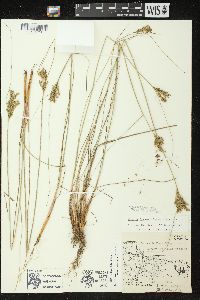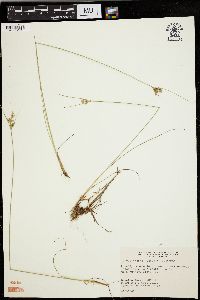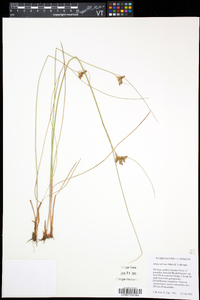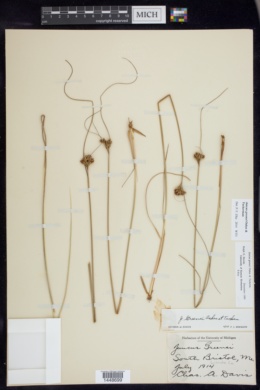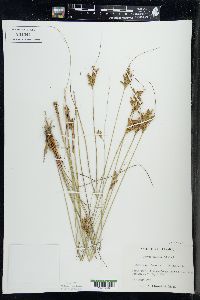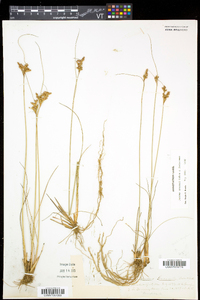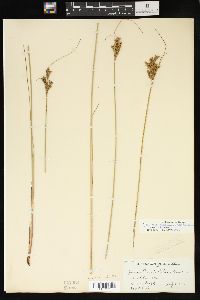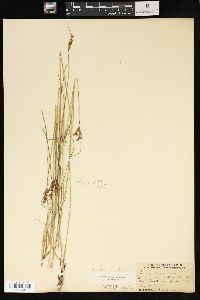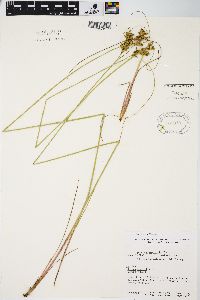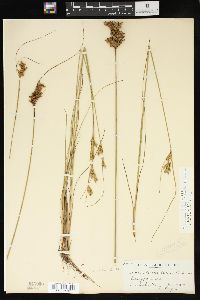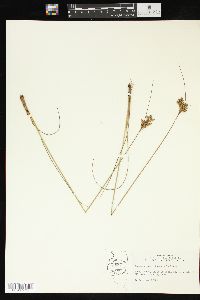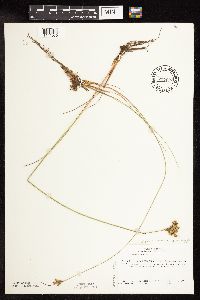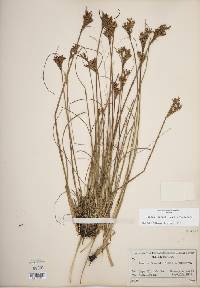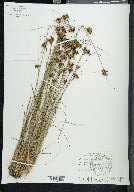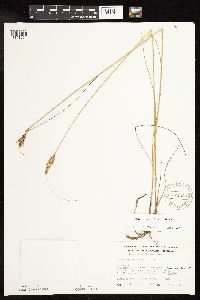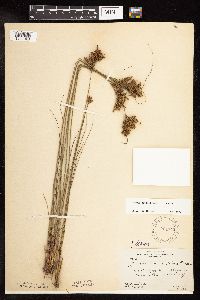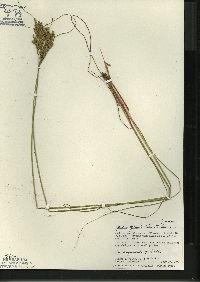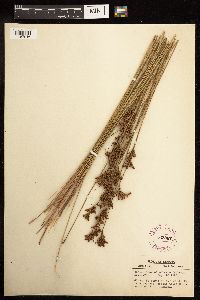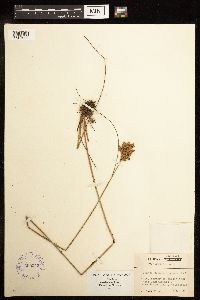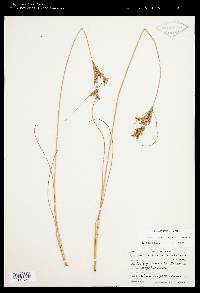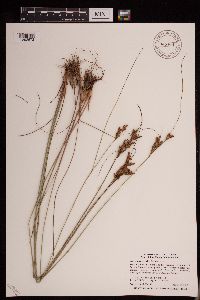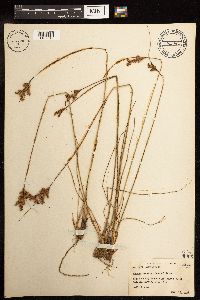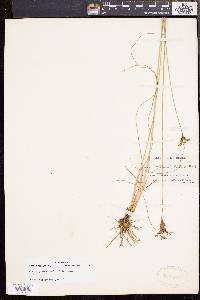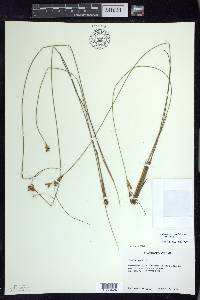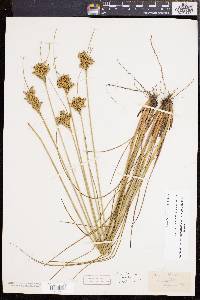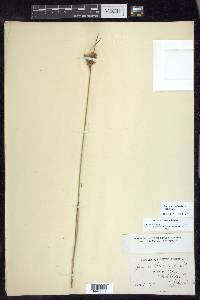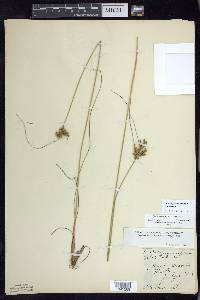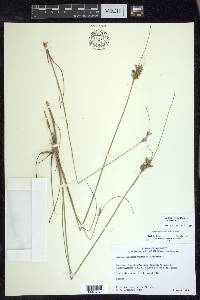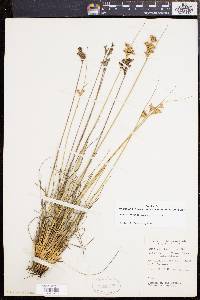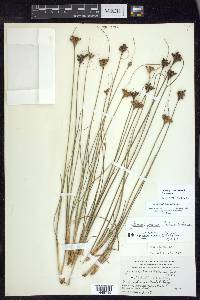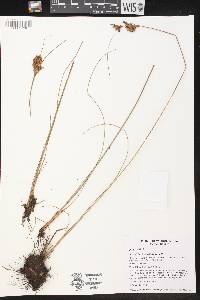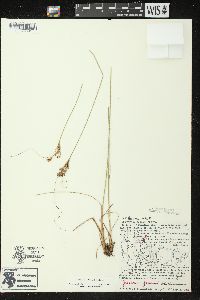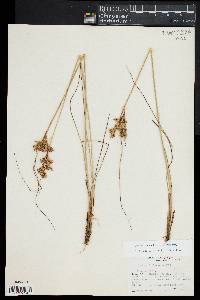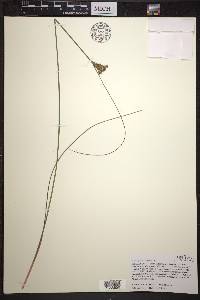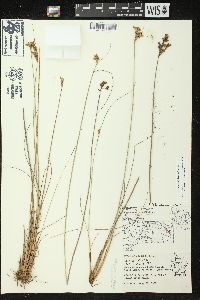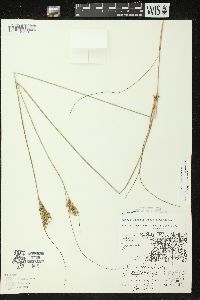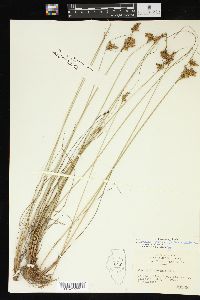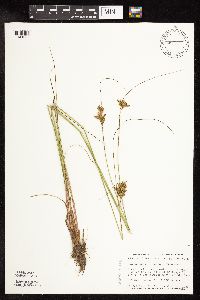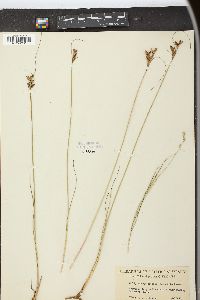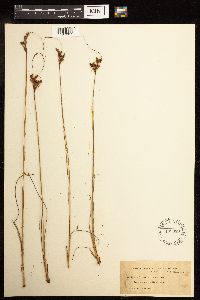Juncus greenei
|
|
|
|
Family: Juncaceae
Greene's Rush
|
Herbs, perennial, tufted, to 7 dm. Rhizomes short, densely branched. Culms 1--30. Cataphylls 1--2. Leaves basal, (1--)2--3; auricles (0.2--)0.4--0.6 (--0.8) mm, scarious, rarely ± leathery; ; blade dark green, nearly terete, 5--30 cm x 0.4--0.8 mm, margins entire. Inflorescences terminal, 5--50-flowered, usually congested, 1--8 cm; primary bract usually surpassing inflorescence. Flowers: bracteoles 2; tepals dark green or darker, lanceolate, 2.5--4.2 mm; outer and inner series nearly equal, apex acute; stamens 6, filaments 0.5--0.8 mm, anthers 0.5--0.8 mm; style 0.2 mm. Capsules chestnut brown or dark brown, infrequently lighter, 3-locular, ellipsoid, (2.5--)2.9--3.5(--4) x (1.1--)1.5--1.8 mm, slightly exceeding tepals, apex somewhat truncate. Seeds dark tan, ellipsoid to lunate, 0.48--0.65--(0.7) mm, not tailed. 2n = ca. 80. Flowering and fruiting summer. Usually dry, well-drained, sandy soil in pine lands, near lake shores, or among sand dunes and often associated with disturbance; N.B., N.S., Ont., P.E.I., Que.; Conn., Ill., Ind., Iowa, Maine, Mass., Mich., Minn., N.H., N.J., N.Y., Ohio, Pa., R.I., Vt., Wis. Perennial grasslike forb up to 70 cm tall Leaves: one to three, basal, dark green, 5 - 30 cm long, 0.4 - 0.8 mm wide, linear, grasslike, almost round in cross section, but lacking crosswise partitions inside (non-septate). The leaves also have a thin and papery (rarely even close to leathery), very short (0.2 - 0.7 mm), ear-like appendage (auricle) at the top of the leaf sheath. Inflorescence: a terminal, 1 - 8 cm long, usually congested, branched structure with five to fifty, single, short-stalked, radially symmetric, small flowers terminating very short branches. The entire branched inflorescence is subtended by a large bract (usually longer than full inflorescence), and the individual short-stalked flowers have two small bracts (bracteoles) positioned directly below the tepals. Stamens: six, with filaments and anthers about same length (0.5 - 0.8 mm). Pistil: with one superior ovary, a 0.2 mm long style, and three stigmas. Fruit: three-chambered, chestnut-brown or dark brown (rarely lighter), 2.5 - 4 mm tall (slightly taller than tepals), 1.1 - 1.8 mm wide, ellipsoid, short-stalked capsules with somewhat abruptly blunt tips. Stems: tufted, erect, smooth, round in cross section, and arising from short, densely branched rhizomes. Seeds: many, dark tan, 0.48 - 0.7 mm long, ellipsoid to crescent-shaped with short-pointed or abruptly narrowed tips, but without distinct narrowed tails at the ends. Tepals: six in two whorls of three, dark green or approaching black, 2.5 - 4.2 mm long, lance-shaped with pointed tips. Similar species: Juncus greenei is most similar to J. vaseyi, but that species has a shorter bract below the inflorescence (shorter than inflorescence), lighter colored capsules, and seeds with clear, long (0.2 - 0.5 mm), narrow tails at each end. It may be possible to confuse this species with J. dudleyi or J. interior, except those species have more open or spreading inflorescences, and flat leaves. Most of the other species in the same subgenus as these four species have flat leaves. Some members of the subgenus Septati may appear similar because they have leaves that are round in cross section, but they also have distinct cross-partitions (septa) in the leaves, and the flowers are grouped in tight clusters or heads. Flowering: June to August Habitat and ecology: Not common, usually in dry, sandy soil such as in sand prairies, flatlands near Lake Michigan, and sterile sandy abandoned fields, but also sometimes in dry non-sandy prairies. Occurence in the Chicago region: native Author: The Field Museum Stems cespitose from a short rhizome, 2-8 dm; basal lvs filiform, subterete, 5-20 cm; invol lvs similar, 2-15(-20) cm; infl small and compact, obpyramidal, 2-5 cm; fls prophyllate; tep lance-oblong, permanently appressed, acute or aristulate, the sep 2.3-4 mm, the pet 1.9-3.4 mm; fr trilocular, ovoid-cylindric, 3-4+ mm, half as thick, truncate, conspicuously surpassing the tep; seeds oblong to obovoid, 0.3-0.6 mm, merely apiculate; 2n=80. Moist to dry, clay or sandy soil, sometimes on dunes; N.B. to N.J., mostly near the coast; also inland from sw. Ont. to Ind., Io., and Minn. Gleason, Henry A. & Cronquist, Arthur J. 1991. Manual of vascular plants of northeastern United States and adjacent Canada. lxxv + 910 pp. ©The New York Botanical Garden. All rights reserved. Used by permission. From Flora of Indiana (1940) by Charles C. Deam Infrequent in the northwestern counties in sandy soil along low roadsides, in moist depressions on the dunes, and especially in prairie habitats along railroads. …… Indiana Coefficient of Conservatism: C = 8 Wetland Indicator Status: FAC |

